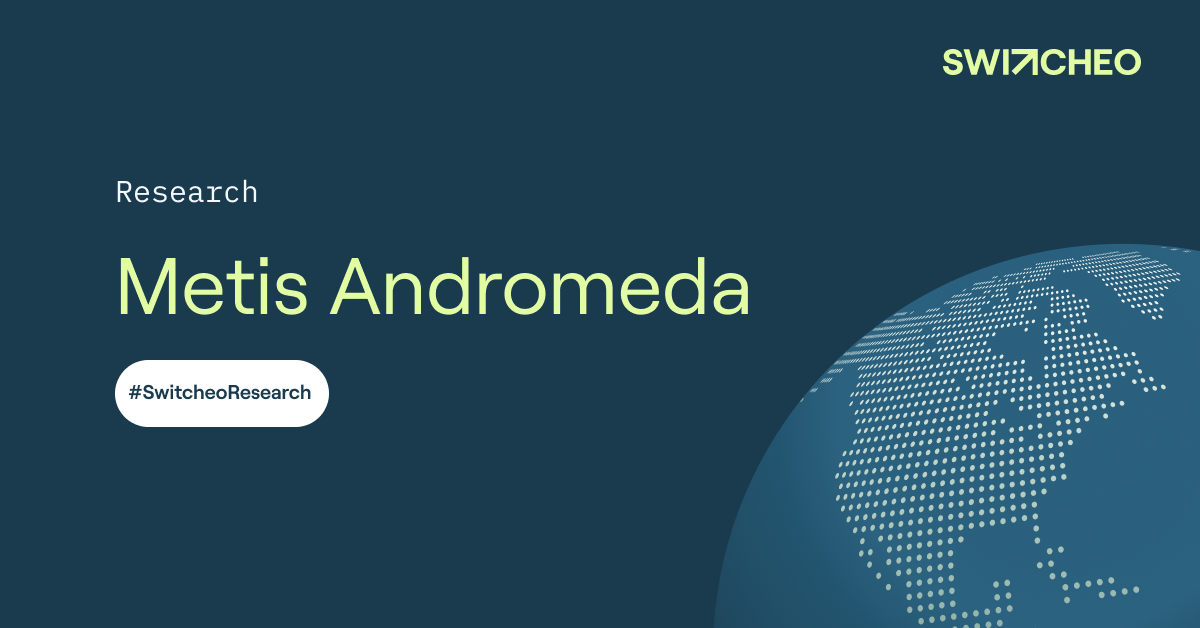Metis Protocol
Metis is a Layer 2 (L2) scaling protocol that uses optimistic rollup technology. Its rollup solution allows developers to run applications, process transactions, and store data on a separate layer above Ethereum.
Since our previous article on L2 solutions, Metis has grown from 3 protocols to 15 protocols operating on their network today. With a current TVL of $377.67 million, up from $100 million since the start of the year, Metis now ranks 2nd in terms of rollups on Ethereum. It is right below Arbitrum, whose TVL is $2.76 billion.
Introduction
Metis mirrors the Optimism Virtual Machine (OVM) that it calls the Metis Virtual Machine (MVM). But unlike its competitors, Metis utilizes multiple sequencers that will be pooled into on-chain units called Decentralized Autonomous Companies (DACs).
DACs are similar to DAOs but include various functionalities of a real company. This allows users to utilize payroll management tools, collaborating tools and other functions such as running a sequencer pool or a new application on the MVM.
Anyone can build a DAC with Metis to establish and govern the partnership and achieve their business goals. Metis also provides a framework to support and manage the implementation of the collaborations transparently and efficiently.
The protocol will randomly select a new sequencer for each block from the sequencer DAC to send any state changes to Ethereum. Sequencers are only eligible to confirm transactions if they have more $METIS staked than the Dynamic Bond Threshold. This serves as a mechanism to disincentivize malicious behavior.
Users can also participate as Rangers to oversee sequencer activity. Rangers will sample a range of blocks and validate the state roots in return for $METIS. Similar to validators, they will be rewarded if they detect any discrepancies while repeated failed challenges can result in a network ban.
Source: Metis Whitepaper
Key Features
Metis aims to make creating dApps and DACs effortless for the everyday blockchain user. The team has optimized Metis to include new features such as:
- Multiple VMs and sequencers
- Framework with templates, APIs, and modules to assist with dApp development
- DACs that can manage their organizations independently
- Separation of computing and storage
- Private native storage layer
- Fast transactions at ~2,000 TPS with low gas fees
- One click deployment with pre-developed templates
- 100% EVM compatible
Metis Bridge
The Metis Bridge supports ERC-20 compatible tokens. Your Polis wallet address is selected by default. $ETH is needed as gas to bridge assets from L1 to L2, and transactions on L2 will be paid for in $METIS.
Here are other ways to bridge assets from another network to $METIS.
Source: Metis Website
Polis - Metis Dashboard
Polis is a platform that allows users to log into any dApps built upon its platform. Users will receive an Ethereum address when creating an account. They can then transfer tokens to other users via their username or Ethereum address. Transaction records across all dApps will be shown on the Polis dashboard.
Protocols on Metis
Agora - Money Market
Agora is a decentralized non-custodial liquidity market protocol where users can deposit or borrow against selected assets. Depositors provide liquidity to the market to earn a passive income, while borrowers are able to borrow in an over collateralized (perpetually) or undercollateralized (one-block liquidity) manner. Agora currently has no native token.
NettSwap - AMM
NettSwap is the first native L2 Decentralized Exchange (DEX) on Metis that uses the same AMM model as Uniswap. As a L2 exchange, it offers low transaction cost, high transaction speed and high scalability to support various bridged and L2 native tokens. NettSwap is the largest DEX on Metis with a TVL of $108 million, and a current mcap of $13 million for $NETT.
Tethys - AMM & Leverage Yield Farm
Tethys is another DEX that was recently launched in Q4 of 2021 on Metis. It provides the network with a fast, secure, and reliable platform to handle all kinds of trades. Additionally, the more you stake your $TETHYS on the farm, the more multipliers you get applied to your harvest amount, up to 30%. $TETHYS has a current mcap of $17 million.
Drachma - AMM & Stableswap
Drachma is an AMM stableswap which features the Curve model of low-slippage swaps for both pegged and unpegged assets. Users can participate as traders or liquidity providers. Drachma will eventually offer protection against impermanent loss for LP providers. LP tokens will also be composable/fungible which will allow them to be used as collateral and easily borrowed against. Drachma currently has no native token.
Starstream - Auto Compounding Vault
Starstream is a yield aggregator with one-click smart contracts on Metis. It provides a suite of products such as auto compounding vaults, which frequently compound interest from vault pools, drastically increasing APYs for liquidity providers. $STARS has a current mcap of $8 million, and is a staking and governance token that earns fees through the various products on Starstream.
Maia - Ohm Fork
Maia is the first community-owned decentralized reserve currency protocol available on Metis. The protocol mints new $MAIA tokens from the treasury and the majority of which are distributed to the stakers. Each $MAIA is backed by a basket of assets (eg. m.USDC, MAIA-m, USDC LP tokens, etc) in the Maia treasury.
This creates an intrinsic value for $MAIA, which allows it to maintain a certain peg. Maia also brings economic and game-theoretic dynamics into the market through staking and minting. $MAIA has a current mcap of $14 million.
Hermes - Solidly AMM Fork
Hermes is low cost DEX with near zero slippage for trades on uncorrelated or tightly correlated assets. The protocol incentivizes fees instead of liquidity and $MAIA holders will benefit directly from Hermes as the DAO will have perpetual collective ownership of 25% of the protocol.
This will allow revenue generation of the treasury via earning fees accrued from liquidity provision, as well as bribe collection. With Solid forks like Hermes appearing, this will bring the ongoing Solid Wars on Fantom to Metis, which would be something interesting to watch out for. Hermes currently has no native token.
Incentive Program
To further incentivize TVL, Metis has launched a US$100 million Genesi fund led by Natalia Ameline - Vitalik’s mother, to support projects that join its ecosystem. This incentive programme is meant to help Metis gain traction against other L1s.
According to Metis, Genesi will be allocated across a wide range of projects in all major crypto verticals including DeFi, GameFi and DAOs. Genesi also enables Metis’ first-mover advantage in the L2 space as the major players, Arbitrum and Optimism have yet to deploy bootstrapping funds on their network.
Tokenomics
The circulating supply of $METIS is currently around 2.8 million, with a total supply of 10 million $METIS.
$METIS distribution
Emission Schedule
Founding Team: 6 months cliff, 12.5% quarterly vesting over Year 1 & 2
MetisLab Foundation: 10% unlocked at TGE, 11.25% quarterly vesting over Year 1 & 2
Advisors: 5% unlocked at TGE, 11.875% quarterly vesting over Year 1 & 2
Angel Investors: 5% unlocked at TGE, 11.875% quarterly vesting over Year 1 & 2
Seed Investors: 10% unlocked at TGE, 22.5% quarterly vesting over Year 1
Private Investors: 10% unlocked at TGE, 22.5% quarterly vesting over Year 1
Strategic Investors: 10% unlocked at TGE, monthly vesting over Year 1
Community Investors: 10% unlocked at TGE, monthly vesting over Year 1
Community Development: 6% over Year 1, 3% over Year 2
Ongoing Emissions:
The remaining 47.7% of the supply will be minted over ten years to support the protocol's transaction mining program.
About 31% of this total (1,486,400) will be released in the first year following Metis' mainnet launch.
The remaining 69% will be emitted over the course of the following nine years.
Source: https://messari.io/asset/metis/profile/supply-schedule
Roadmap
Q1 2022: Verifiers will conduct real-time verifications, shortening the transaction finality. With the current withdrawals from L2 to L1 taking days, this will drastically improve the transactions to a few hours, and eventually it would take just a few minutes.
Q2 2022: The Metis Sequencer Pool will be open to the community. All verifiers will automatically be added into the pool. A challenge and voting mechanism will ensure that sequencer positions rotate efficiently.
Q3 2022: The cloud deployment code will be released for both main and peer nodes, enabling everyone to run a Metis node with high security and efficiency.
Q4 2022: When Metis reaches the final stage of development, the L2 infrastructure will have achieved 100% decentralization. No other rollup, commit chain, side chain, or any kind of Ethereum scaling solution can make this claim.
Team
@ElenaCryptoChic - Founder | CEO
@kevinliub - Founder | Product Lead
Yuan Su - Founder | Tech Lead
@Natalia_Ameline - Genesi DAC Manager | Vitalik’s Mom
Caria Wei - Product Development Manager | Head of Operations
Norbert Amnakwaa Adomako - Chief of Communications | Community Manager
Vaishnav Rahul - Website Developer | Administrator
Doug Witt - Business Development Director
Conclusion
I believe that Metis on track to achieve their goals, with the protocol hitting every milestone on their roadmap thus far. As more protocols realize how cheap and easy it is to build on Metis, we will see the TVL of Metis increase drastically as it attracts more users and developers.
Currently, Metis is the only L2 that uses its native token $METIS as gas currently while the other L2 rely on $ETH. This could be bullish for the protocol as it gives users and developers the convenience of using $METIS while operating on their network. Additionally, with the help of Vitalik Buterin’s mother and a strong management team, the future is bright for Metis.


